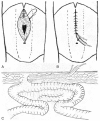Continuous irrigation and suction with a triple-cavity drainage tube in combination with sequential somatostatin-somatotropin administration for the management of postoperative high-output enterocutaneous fistulas: Three case reports and literature review
- PMID: 31725672
- PMCID: PMC6867794
- DOI: 10.1097/MD.0000000000018010
Continuous irrigation and suction with a triple-cavity drainage tube in combination with sequential somatostatin-somatotropin administration for the management of postoperative high-output enterocutaneous fistulas: Three case reports and literature review
Abstract
Introduction: Enterocutaneous fistula is considered one of the most serious complications in general surgery and is associated with high morbidity and mortality. Although various treatments are reported to have varying success, high-output enterocutaneous fistulas (output over 500 ml/day) continue to be associated with high mortality, and few papers on this topic exist in the literature. The aim of this study is to describe an effective multidisciplinary treatment method for postoperative high-output enterocutaneous fistula and discuss the clinical development of the therapeutic strategy.
Patient concerns: Three patients suffered high-output enterocutaneous fistulas, in which case 1 presented with duodenal fistula, case 2 with ileal fistula, and case 3 with small bowel fistula.
Diagnosis: All 3 cases were diagnosed with high-output enterocutaneous fistulas by drainage of intestinal contents.
Interventions: With the exception of routine treatment including fluid resuscitation, correction of the electrolyte balance, control of infection, and optimal nutrition, all the cases accepted continuous irrigation and suction with triple-cavity drainage tubes in combination with sequential somatostatin-somatotropin administration were given. With regard to establishing effective drainage, the triple-cavity tube placement was performed by insertion through the initial drainage channel in case 1, percutaneous puncture with dilation by graduated dilators in case 2, and tract reconstruction in case 3. The technical details of the approach are described and clinical characteristics including fistula location, defect size, output volume, approach of triple-cavity tube placement, length of fistula tract, somatostatin and somatotropin administration time, and fistula healing time were recorded and compared. In addition, other various techniques reported in the literature are reviewed and discussed.
Outcomes: All the patients were cured by the multidisciplinary treatments and were followed up without fistula recurrence and other relevant complications at 1 week, 1 month, and 3 months after the treatments.
Conclusion: The strategy involving continuous irrigation and suction with a triple-cavity drainage tube in combination with sequential somatostatin-somatotropin administration may be a safe and effective alternative treatment for postoperative high-output enterocutaneous fistula and a more practical method that is easy to execute to manage this problem. Long-term studies, involving more patients, are still necessary to confirm this suggestion.
Conflict of interest statement
The authors have no conflicts of interest to disclose.
Figures



Similar articles
-
Percutaneous management of enterocutaneous fistulas.AJR Am J Roentgenol. 1996 Jul;167(1):33-8. doi: 10.2214/ajr.167.1.8659416. AJR Am J Roentgenol. 1996. PMID: 8659416
-
Treatment of enterocutaneous fistulas with TPN and somatostatin, compared with patients who received TPN only.Br J Clin Pract. 1990 Dec;44(12):616-8. Br J Clin Pract. 1990. PMID: 1983231 Clinical Trial.
-
Nutrition and management of enterocutaneous fistula.Br J Surg. 2006 Sep;93(9):1045-55. doi: 10.1002/bjs.5396. Br J Surg. 2006. PMID: 16804873 Review.
-
Artificial nutritional support in patients with gastrointestinal fistulas.World J Surg. 1999 Jun;23(6):570-6. doi: 10.1007/pl00012349. World J Surg. 1999. PMID: 10227926 Review.
-
[Investigation of treatment and analysis of prognostic risk on enterocutaneous fistula in China: a multicenter prospective study].Zhonghua Wei Chang Wai Ke Za Zhi. 2019 Nov 25;22(11):1041-1050. doi: 10.3760/cma.j.issn.1671-0274.2019.11.007. Zhonghua Wei Chang Wai Ke Za Zhi. 2019. PMID: 31770835 Chinese.
Cited by
-
Initial suction drainage decreases severe postoperative complications after pancreatic trauma: A cohort study.World J Gastrointest Surg. 2023 Aug 27;15(8):1652-1662. doi: 10.4240/wjgs.v15.i8.1652. World J Gastrointest Surg. 2023. PMID: 37701705 Free PMC article.
-
Precise placement of a triple-cavity drainage tube by guide wire exchange method for esophagojejunal anastomotic fistula after gastrectomy.World J Surg Oncol. 2023 Oct 27;21(1):344. doi: 10.1186/s12957-023-03224-1. World J Surg Oncol. 2023. PMID: 37891613 Free PMC article.
-
Exploration of critical care nurses' challenges in caring for enterocutaneous fistula as a complication for an open abdomen: A qualitative study.Health Sci Rep. 2024 May 13;7(5):e2051. doi: 10.1002/hsr2.2051. eCollection 2024 May. Health Sci Rep. 2024. PMID: 38742090 Free PMC article.
-
Application Effect of Somatostatin Combined with Transnasal Ileus Catheterization in Patients with Acute Intestinal Obstruction and Advanced Gastric Cancer.Comput Intell Neurosci. 2022 Jun 11;2022:9747880. doi: 10.1155/2022/9747880. eCollection 2022. Comput Intell Neurosci. 2022. Retraction in: Comput Intell Neurosci. 2023 Nov 29;2023:9835626. doi: 10.1155/2023/9835626. PMID: 35726291 Free PMC article. Retracted. Clinical Trial.
References
-
- Majercik S, Kinikini M, White T. Enteroatmospheric fistula: from soup to nuts. Nutr Clin Pract 2012;27:507–12. - PubMed
-
- Woodfield JC, Parry BR, Bissett IP, et al. Experience with the use of vacuum dressings in the management of acute enterocutaneous fistulas. ANZ J Surg 2006;76:1085–7. - PubMed
-
- Leang YJ, Bell SW, Carne P, et al. Enterocutaneous fistula: analysis of clinical outcomes from a single Victorian tertiary referral centre. ANZ J Surg 2018;88:E30–3. - PubMed
-
- Foster CE, 3rd, Lefor AT. General management of gastrointestinal fistulas. Recognition, stabilization, and correction of fluid and electrolyte imbalances. Surg Clin North Am 1996;76:1019–33. - PubMed
-
- Soeters PB. Gastro-intestinal fistulas: the role of nutritional support. Acta Chir Belg 1985;85:155–62. - PubMed
Publication types
MeSH terms
Substances
LinkOut - more resources
Full Text Sources

